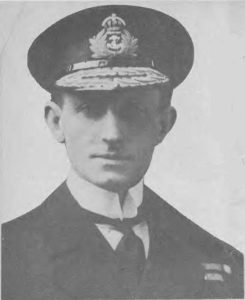- Author
- Cousins, Edna
- Subjects
- Biographies and personal histories
- Tags
-
- RAN Ships
- HMAS Australia I, HMAS Sydney I, HMAS Melbourne I
- Publication
- January 1972 edition of the Naval Historical Review (all rights reserved)

SYDNEY CAN CLAIM with a great deal of pride that it is the birthplace of a man who has made not only Australian, but Commonwealth Naval History.
In the harbourside suburb of Rose Bay, in a beautiful old home which has since been converted into a college, John Saumarez Dumaresq was born on 26th October 1873. At an early age his parents took him home to England. Following a strong inclination he entered the Royal Navy at the age of twelve, thus starting a great, but what was, unfortunately, to be too brief a career.
Passing through various grades of the Service, his aptitude brought him under the notice of Authority, and at an early age he was created a Lieutenant and commenced the specialisation in torpedo work and gunnery which was to make him famous.
John Dumaresq’s special abilities seemed to lie along the lines of inventing gear to improve the current system of gunnery, and he devised special instruments, one in particular – the Dumaresq Range Finder – calculated to improve gun fire control and for determining the rate of movement of enemy ships. His inventions proved invaluable during World War I.
On 31st May 1916, then a Captain, he took part in the famous action of Jutland, aboard his ship HMS Shannon. He led the line of cruisers that screened Admiral, later Lord, John Jellicoe’s battleships. For his part in the battle he was created a CB.
In February 1917 he took command of HMAS Sydney I, thus becoming associated for the first time with the young Navy of his native land. Whilst aboard Sydney, Captain Dumaresq brought into being the first revolving platform for carrying aircraft aboard light cruisers. It seemed fitting that Sydney had the honour of being the first ship to be equipped with this modern adjunct to naval warfare.
On 4th May 1917 Sydney was Flagship of her Squadron, composed of HMS Dublin and four destroyers doing patrol duties in the vicinity of the Dogger Bank, when a Zeppelin was sighted. The command was given to scatter, so they separated, thus offering smaller targets for the enemy to bomb. At first the Germans did not attack the patrol, but signalled to several U-boats who had arrived on the scene. The LBDs succeeded in sinking two of the U-boats by gunfire and then the Zeppelin turned her attention to the Sydney, dropping bombs in quick succession. Captain Dumaresq’s cleverness in manoeuvring the Sydney saved her from destruction.
When Sydney went up for refit, Captain Dumaresq was transferred to the battle cruiser HMS Repulse. Whilst in command he again earned distinction with his ship on 17th November 1917, at the second battle of Heligoland.
After the signing of the Armistice in 1918, young Captain Dumaresq was promoted to the rank of Commodore, First Class, flying his broad pennant from HMAS Australia. It must have been a very proud day for Commodore Dumaresq, when on Sunday 15 June 1919, Australia’s own battle cruiser and her first Australian born Commodore arrived in Sydney Harbour. Two years later Australia had her own Rear Admiral, for Commodore Dumaresq was raised to that rank, thus becoming the first Australian to command the Royal Australian Navy. This post he held from 1919 to 1922 and during that period, he gained another distinction, that of being the first Australian Naval Officer appointed ADC to the late King George V.
Although the Rear-Admiral was a strict disciplinarian, he was very popular with his subordinates and indeed, loved by all who knew him, for his kind and cheerful disposition. He took a keen interest in sailing and entered in many of the 18ft skiff races on Sydney Harbour.
His last notable exploit took place in January 1922 when he was proceeding to New Zealand aboard his flagship, HMAS Melbourne, when, in a cyclone in the Tasman, the radio operator picked up an SOS from the sinking American schooner Helen B. Stirling, and proceeded to effect a spectacular and gallant rescue. USA showed her appreciation of this sea epic by presenting a gold watch and chain to the Rear Admiral and gold medals for the boat’s crew.
After commanding the RAN for three years, during which time he brought the Fleet to a high standard of efficiency, the young Rear Admiral left for England by way of Japan aboard the Japanese line TSS Tango Maru. Nearing the Philippines Islands, Rear Admiral Dumaresq took seriously ill. He was taken ashore at Manila to the American Military Hospital. After a valiant fight for life Rear Admiral John Saumarez Dumaresq passed away on 22nd July 1922. He was buried with full Naval and Military honours at Manila.
Paraphrasing the poet, we can say Rear Admiral Dumaresq’s resting place will be, not only to his native land, but to the British Commonwealth, a place ‘forever Australia.’




